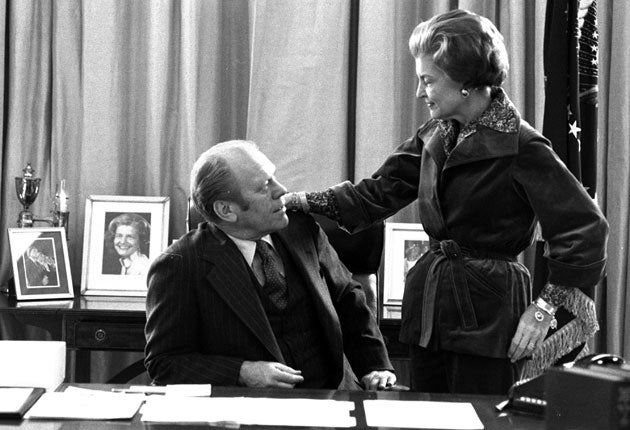Betty Ford, former first lady, dies at 93
Her openness about her problems means she has left an enduring legacy

Betty Ford, the former US first lady whose triumph over drug and alcohol addiction became a beacon of hope for addicts and the inspiration for her Betty Ford Center in California, died on Friday. She was 93. Her husband, former president Gerald Ford, died in 2006.
Ex-president George H W Bush said: "She was a wonderful wife and mother, a great friend and a courageous first lady. No one confronted life's struggles with more fortitude or honesty, and as a result, we all learned from the challenges she faced."
During and after her years in the White House, 1974-77, Mrs Ford won acclaim for her candour, wit and courage as she fought breast cancer, severe arthritis, and the twin addictions of drugs and alcohol. She also pressed for abortion rights and women's rights. While her husband served as president, Mrs Ford's comments weren't the kind of genteel, innocuous talk expected from a first lady, far less a Republican one. Her unscripted comments sparked momentary squalls in the press and dismayed President Ford's advisers, who were trying to soothe the national psyche after Watergate. But to the scandal-scarred, Vietnam-wearied, hippie-rattled nation, her openness was refreshing. And 1970s America loved her for it.
But it was her Betty Ford Center, which rescued celebrities and ordinary people from addiction, that made her famous in her own right. "People who get well often say, 'you saved my life', and 'you've turned my life around,'" she recalled. "They don't realise we merely provided the means for them to do it themselves and that's all." The Betty Ford Center – although most famous for celebrity patients such as Elizabeth Taylor, Johnny Cash and Lindsay Lohan – has served more than 90,000 people.
She would build an enduring legacy by opening up the toughest aspects of her life as a public example. In an era when cancer was discussed in hushed tones and mastectomy was still a taboo subject, Mrs Ford shared the specifics of her breast cancer surgery. The publicity helped to bring the disease into the open and inspired countless women to seek breast examinations.
Her most painful revelation came 15 months after leaving the White House, when she announced that she was entering treatment for a long-standing addiction to painkillers and alcohol. It turned out the famously forthcoming first lady had been keeping a secret, even from herself.
After she and her husband had retired, she went to work on her memoirs, The Times of My Life, which came out in 1979. But the social whirlwind that engulfed them in Washington was over, and Mrs Ford confessed that she missed it. She would later describe herself during that period as "this nice, dopey pill-pusher sitting around and nodding."
"As I got sicker," she recalled, "I gradually stopped going to lunch. I wouldn't see friends. I was putting everyone out of my life." Her children recalled her living in a stupor, shuffling around in her dressing gown, refusing meals in favour of a drink. Her family finally confronted her in April 1978 and insisted she seek treatment. She credited their "intervention" with saving her life. "I was stunned at what they were trying to tell me about how I disappointed them and let them down," she told the Associated Press in 1994. "I was terribly hurt – after I had spent all those years trying to be the best mother and wife I could be. Luckily, I was able to hear them saying that I needed help, and they cared too much about me to let it go on," she said.
She entered Long Beach Naval Hospital and underwent a tough detoxification, which became the model for therapy at the Betty Ford Center. She helped to raise $3m, lobbied in the state capital for its approval, and reluctantly agreed to let it be named after her. Her efforts won her a Presidential Medal of Freedom, the nation's highest civilian honour, from the first President Bush in 1991. In 1999, Gerald and Betty Ford were both awarded Congressional Gold Medals.
Mrs Ford was a free spirit from the start. Born Elizabeth Bloomer on 8 April 1918, she fell in love with dance as a girl in Grand Rapids, Michigan. At 20, despite her mother's misgivings, she moved to New York City to learn from her idol, Martha Graham. She lived in bohemian Greenwich Village, worked as a model, and performed at Carnegie Hall in Graham's modern dance ensemble. After returning to Michigan , where an early marriage to a furniture company representative ended in divorce, she met Gerald Ford, a lawyer just out of the navy. When he proposed in 1948, she said later, she had no idea that he was planning a political career.
Join our commenting forum
Join thought-provoking conversations, follow other Independent readers and see their replies
Comments